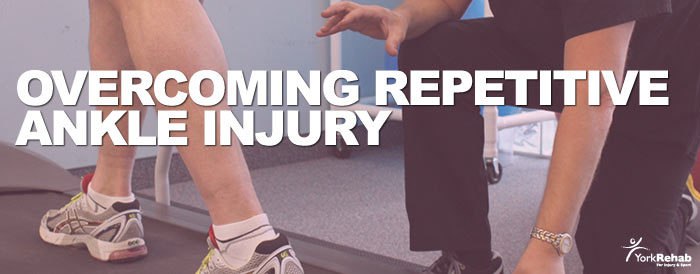
Overcoming Repetitive Ankle Injuries


A common injury for people involved in sports such as soccer, tennis, squash, or running is an ankle sprain. Many athletes and weekend warriors alike have experienced this injury, often multiple times, and may rely on using a brace for support to prevent re-injury or be forced to cut back on their participation due to recurring injury. It is possible to minimize the recurrence rate of this injury by seeing a qualified physiotherapist who can assess for and address the following limitations that are common in people with repetitive ankle injuries.
Some people who have had a long history of ankle injury have range of motion limitations. What can happen is the ankle swells following the sprain, and it gradually recovers, but the scar tissue that forms to rebuild the injured tissue does not get adequately stretched. This is how a stiff ankle can develop, and playing sports with this movement loss can lead to another injury quickly. A physiotherapist can identify these limitations and prescribe the proper stretches to recover as much mobility as possible.
Secondly, following the recovery from an acute (within 6 weeks of injury) ankle sprain there might not be any residual pain, but often there is a lingering weakness. Because the ankle feels free of pain the athlete is compelled to return to their sport, neglecting the strength deficits that are present. Depending on the sport, this might manifest as decreased endurance, overall strength, or explosive power such as in jumping sports. This can be remedied by regularly performing the appropriate exercises specific to your sport, exercises which can be determined by a physiotherapist.
A hidden impairment that an athlete may not notice after an ankle injury is decreased proprioception. This refers to the “position sense” of your joints and ligaments, similar in a way to other senses such as vision and smell. There are sensors embedded in these tissues that give the body feedback about where it is in physical space, and we rely on this sense to maintain good balance and stability during weight-bearing activity. After an ankle sprain, we often lose some of this sense, but it can be readily retrained much like muscle strength can. Specific balance exercises can be done to regain this sense, with progressions to sport-specific activity.
Building on that last point, before returning to your activity is considered, an athlete should be able to perform the necessary tasks involved in the activity. For example, a soccer player should be able to sprint, change directions quickly, kick, and dribble a ball. Often the speed at which these activities can be done following an ankle injury is much less than in normal conditions. Agility exercises and plyometrics, which are a type of exercise involving explosive movements such as jumps and sprints, are essential here. Regaining these skills is crucial to minimize the risk of long-term ankle injury recurrences.
To summarize, if you have had trouble with repetitive ankle injuries, you should consider seeing a physiotherapist who will assess to see if any impairments discussed above are present and design the optimal program for you to address them. Frequently the solution to the problem is relatively simple; it just takes some diligence to stick with the program to see results. Instead of worrying about your ankle every time you return to activity, wouldn’t it be nice to pivot, jump, sprint or whatever you do with confidence? You can make that a reality following an individualized physiotherapy regimen to help with your recovery, so you can get you back in the game as quickly and safely as possible.
Comments are closed.

